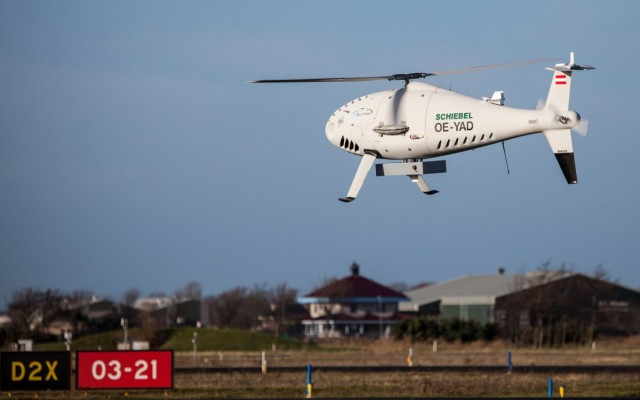 Schiebel and the Netherlands Aerospace Centre (NLR), the Netherlands Coastguard and the Royal Netherlands Air Force conducted a series of at the airport of Den Helder in December 2015. The AIRICA (ATM Innovative RPAS Integration for Coastguard Applications) project marks a major step forward in the process of safe integration of RPAS (Remotely Piloted Aircraft Systems) into all classes of airspace.
Schiebel and the Netherlands Aerospace Centre (NLR), the Netherlands Coastguard and the Royal Netherlands Air Force conducted a series of at the airport of Den Helder in December 2015. The AIRICA (ATM Innovative RPAS Integration for Coastguard Applications) project marks a major step forward in the process of safe integration of RPAS (Remotely Piloted Aircraft Systems) into all classes of airspace.
During a special demonstration held at De Kooy Airfield in Den Helder, Schiebel provided it ́s unmanned helicopter, the CAMCOPTER S-100, onto which the NLR developed AirScout Detect and Avoid System was installed. The Netherlands Coastguard provided a Dornier Do-228 as “intruder” and the Royal Netherlands Air Force contributed with an Alouette helicopter as “intruder”, and provided the Air Traffic Control services.
Several scenarios were successfully executed where the CAMCOPTER S-100 “unexpectedly” encountered an intruder aircraft. The system then determined in real time the corrective action to ensure the necessary separation from the intruder aircraft.
The AIRICA project is funded through the European SESAR programme (part of the Single European Sky initiative) and the key focus – integration of an RPAS into the airspace for Netherlands Coast Guard ́s applications – was effectively demonstrated during the flights.
Edwin van der Pol, Head of Operations Kustwacht: ”In the future we hope to use unmanned systems for our search and rescue operations. These trials are important to achieve regulations for bringing RPAS into non-segregated airspace.”
Chris Day, Head of Capability Engineering at Schiebel: “This demonstration is another positive step towards unmanned air systems gaining access to a broader range of airspace.”
About Schiebel
Founded in 1951, the Vienna-based Schiebel Group focuses on the development, testing and production of state-of-the-art mine detection equipment and the revolutionary CAMCOPTER S-100 Unmanned Air System (UAS). Schiebel has built an international reputation for producing quality defense and humanitarian products, which are backed by exceptional after-sales service and support. In 2010, Schiebel’s new composite division has started to supply high-tech customers with products of supreme carbon fiber technology – all quality-controlled to meet ISO 9001 standards. With headquarters in Vienna (Austria), Schiebel now maintains production facilities in Wiener Neustadt (Austria) and Abu Dhabi (UAE), as well as offices in Washington DC (USA) and Phnom Penh (Cambodia).
About the CAMCOPTER S-100
Schiebel’s CAMCOPTER S-100 Unmanned Air System (UAS) is a proven capability for military and civilian applications. The Vertical Takeoff and Landing (VTOL) UAS needs no prepared area or supporting launch or recovery equipment. It operates in day and night, under adverse weather conditions, with a beyond line-of-sight capability out to 200 km, both on land and at sea. The S-100 navigates via pre- programmed GPS waypoints or is operated with a pilot control unit. Missions are planned and controlled via a simple point-and-click graphical user interface. High definition payload imagery is transmitted to the control station in real time. Using “fly-by-wire” technology controlled by a triple-redundant flight computer, the UAV can complete its mission automatically. Its carbon fiber and titanium fuselage provides capacity for a wide range of payload/endurance combinations up to a service ceiling of 18,000 ft. In its standard configuration, the CAMCOPTER S-100 carries a 75 lbs/34 kg payload up to 10 hours and is powered with AVGas or heavy fuel.
Source: Press Release

Fantastic!…could I please have an estimate on how long I can expect to have a job flying helicopter tours? The reality of autonomous controlled helicopter’s could soon make the pilot obsolete. I just want to anticipate the transition so it won’t catch me off guard like the factory workers in the automobile industry. Best wishes,
Steve